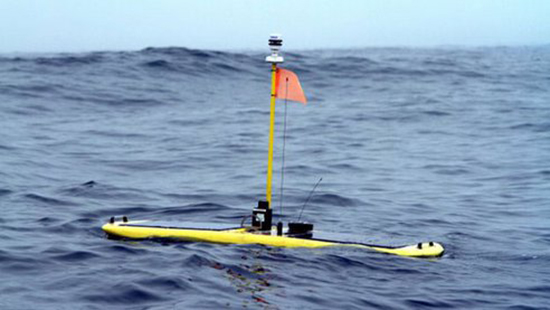From Treehugger , a post by Jaymi Heimbuch on a new technology that is being used to explore the oceans.
Last November, Liquid Robotics let loose four Wave Gliders in the Pacific ocean. The autonomous robots — outfitted with sensors that measure and collect information on a variety of substances, from oil spills to salinity levels to weather information — are wave-powered, using the rolling motion of the water to propel forward. It’s a slow, slow journey traveling at about 1.5 knots, but one Wave Glider, named “Papa Mau”, has completed the 9,000 nautical mile trip across the Pacific, leaving a world record for longest autonomous trip in its wake.
A press release from Liquid Robotics states, “During Papa Mau’s journey, he weathered gale force storms, fended off sharks, spent more than 365 days at sea, skirted around the Great Barrier Reef, and finally battled and surfed the East Australian Current (EAC) to reach his final destination in Hervey Bay near Bundaberg, Queensland, Australia. He traveled through and measured over 1200 miles of a chlorophyll bloom along the Equatorial Pacific. These blooms indicate proliferation of phytoplankton that is fundamental to ocean life and climate regulation. While typically monitored through satellite imagery direct validation of chlorophyll blooms at this resolution provides a groundbreaking link between scientific modeling and in-situ measurement of the Pacific Ocean.”
This link between new ways of sensing and modeling information about the ocean is the goal of Liquid Robotics — to provide real-time information about the ocean on a vast array of issues. Papa Mau may have set a record for distance, but these Wave Gliders are doing much more than that. They are proving to be an important new technology for understanding the state of our oceans.
“We’ve demonstrated delivery of ocean data services through the most challenging ocean conditions. Mission accomplished,” said Bill Vass, CEO of Liquid Robotics.
As Fast Company notes, “The Wave Glider is currently being used for up to 60 different applications, including helping ships reduce fuel consumption, measuring carbon output, helping wit fishery management, and oil and gas exploration… [T]he Wave Glider can detect oil spills in remote places where they might otherwise have gone unnoticed for too long. With so many capabilities, it’s no surprise that Wave
